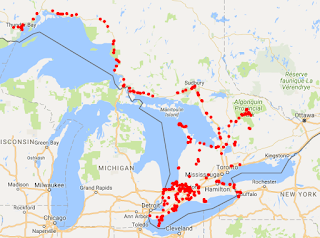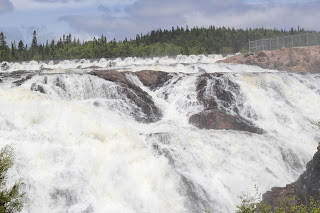This past weekend, I went to Algonquin Park with a group of young birders. It was quite a lot of fun, and we saw many, many things (most of which I am lacking photos!) We stayed at the Wildlife Research Station (WRS), which offered great wildlife sightings just outside our door. The first of many things seen were Chalk-fronted Corporals.
We went for a walk around WRS, where we turned up a few good birds, and got our first taste of summer birding in Algonquin.
 |
| American Redstart |
That evening, we checked out the Old Railway Bed.
This turned out to be great for mammals. We managed to find multiple Beavers, two Moose, and even a Black Bear.
Birds were around, but most were found by ear alone. The best birds by far were a Barred Owl and a Northern Saw-whet Owl, both of which were heard off in the distance.
 |
| Wood Ducks |
On the way back, near Cannisbay, some of us were lucky to see an Algonquin/Eastern Wolf cross the road. I only managed to catch the tail end of it in the lead car's headlights.
The next day, we went canoeing in Hailstorm Creek (north arm of Lake Opeongo). Many things were seen, including some River Otters, Ring-necked Ducks, Elegant Spreadwings, and four Sandhill Cranes. We also found a few boreal birds.
 |
| Ring-necked Duck |
 |
| Elegant Spreadwing |
 |
| River Otter |
 |
| Red Crossbill |
The breeding colony of Double-crested Cormorants and Herring Gulls continues.
 |
| Double-crested Cormorants |
One of my favourite birds was found regularly on Opeongo.
 |
| Common Loon |
We went out looking for herps after we got back. All we could find was a Red-backed Salamander.
The next day, we went with the small mammal researcher in the early morning to see what research she was doing. It was quite interesting, even if all we caught were a shrew and Deer Mice.
Birds were pretty easy to find around WRS.
 |
| Purple Finch |
 |
| Cedar Waxwing |
We explored the Old Airfield, where we managed to find some Pink-edged Sulphurs.
This Snowshoe Hare wasn't concerned about our presence.
We were happy to find a Boreal Chickadee.
As if the Red Crossbills from the day before weren't enough, White-winged Crossbills decided to show up.
To cap off the Airfield, my favourite warbler provided great looks.
 |
| Magnolia Warbler |
We went to the Visitor Centre and checked out their private collections. Afterwards, we managed to locate the Olive-sided Flycatcher of the viewing deck.
I pretty much just left my camera behind for the rest of the day, so you'll just have to visualize this stuff....
We went looking for salamanders at Found Lake. It was much harder than expected, but Red-backed and the uncommon Northern Two-lined were eventually found.
We went to the airfield again to see if we could find the Long-eared Owls which had been rumoured to be hanging out there. No owls, but a Merlin was a nice treat.
The next morning, we started out at the Airfield around 5:20 am. We were hoping that a rarity had dropped in or something (Dickcissel seemed like the most likely). While nothing of that sort was found, we found a Wild Turkey, which is great for the park.
Spruce Bog was our next stop. While the Spruce Grouse evaded us, a singing Olive-sided Flycatcher rewarded us. Common Yellowthroats were common as well.
 |
| Yellowthroat |
Opeongo Road proved to be very productive. Canada Warblers were heard soon after turning onto the road, and many more warblers could be seen and heard.
 |
| Yellow-rumped Warbler |
Opeongo Rd was flycatcher central, and we found four species. Olive-sided was surprisingly the most plentiful, with four individuals.
Yellow-bellied Flycatcher had three individuals.
Alder and Least Flycatcher both had only one representative.
 |
| Alder |
Gray Jays were also found, and came very quickly to be fed.
White Admirals were seen here and there.
While the rest of the group went back to WRS, a few of us braved the bugs and continued on birding, trying to get our list up to 100 species (I think we just fell short, with something like 98 or 99).
The only new bird found was an American Woodcock which I flushed while bushwhacking in a spruce bog. It was the last new bird of the trip.
After saying good-bye to the group, my family continued to explore Algonquin.
The Airfield had some good leps and odes, including a skipper of which I don't know what to think. It looks a lot like a Leonard's Skipper, but it just seems too dark and pretty early for one. If you can help me, I'd be very thankful! (EDIT: Long Dash - thanks Nate!)
 |
| Long Dash |
 |
| Calico Pennant |
The Algonquin Art Centre had a Common Raven that was begging for handouts.
As we were leaving the park, we came across this Moose.
Later that evening, we came back to see what was around the Railway Bed. Nothing much except for a couple of Wilson's Snipe and a Muskrat.
The next morning, we went to Opeongo Rd again. No Gray Jays, but the Olive-sideds were cooperating. I got better photos than the day before.
I didn't take any more photos after that, mostly because everything was heard but not seen. We left Algonquin around three.
Overall, it was an awesome trip, and I can't even begin to share everything that happened in a blog post. It was one of those times that you can't put into words.
Whoever said birding in July is the slowest is quite wrong....I'm at 136 species so far this month!!! (EDIT: Upland Sandpipers, Bobolink, and Dickcissel make it 139!)

























































































